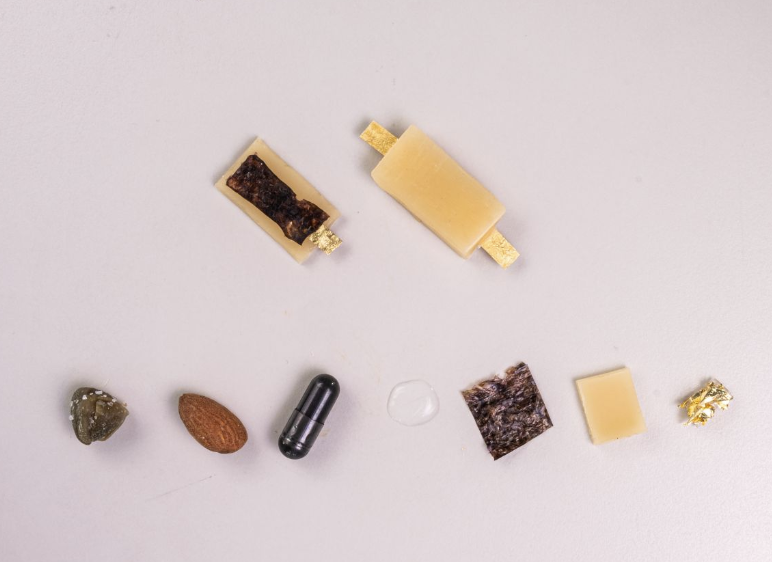One would not usually consider sitting down with a plate full of copper wiring, circuit boards, and other electronic components as part of a balanced diet, but finding materials to develop edible electronics is a field on the rise, particularly when it comes to developing ingestible electronics for healthcare applications.

Image Credit: Istituto Italiano di Tecnologia (IIT-Italian Institute of Technology)
Researchers at the Istituto Italiano di Tecnologia (IIT-Italian Institute of Technology) have recently proved proof-of-concept that they can create an edible rechargeable battery using basic food ingredients and additives found in a typical daily diet.
Published in Advanced Materials, the IIT team claims that the potential edible and rechargeable battery could be applied in healthcare diagnostics, edible soft robotics, and monitoring food quality.
Moreover, edible electronics could even be used in products aimed at children, says lead author of the study Mario Caironi, coordinator of the Printed and Molecular Electronics laboratory of the IIT Center in Milan (Italy).
Given the level of safety of these batteries, they could be used in children toys, where there is a high risk of ingestion. Actually, we are already developing devices with greater capacity and reducing the overall size. These developments will be tested in future also for powering edible soft robots.
Mario Caironi, Coordinator of the Printed and Molecular Electronics Laboratory, IIT
Safer and Easier Medical Diagnostics
Caironi and his team have focused on studying the electronic properties of food, food additives, and any by-products to create new biocompatible edible electronics. In 2019, the ERC awarded Caironi a consolidator grant worth 2 million euros for the ELFO Project, an initiative focused on exploring the edible electronics field.
One of the main reasons for the surging interest in edible electronics revolves around creating safer and easier diagnostic pathways for gastrointestinal tract diseases in addition to better quality monitoring and control of food products. Yet, like any electronic device, one of the most significant challenges is ensuring power sources are safe for ingesting.
It is well-known that ingesting batteries is a major health hazard, especially Lithium-ion batteries, the most common battery units in circulation today. So, the impetus for finding the right materials to use with both the safety and energy benefits required for powering ingestible devices is crucial.
Inspired by living organisms that utilize redox cofactors to supply power to biochemical machines, the IIT team developed their rechargeable edible battery using materials that are consumed as part of a typical human diet.
This concept could then have the potential to usher in easier and safety diagnostic tools for patients that require internal diagnostics of the gastrointestinal tract.
Through the immobilization of riboflavin and quercetin, which are found in a variety of common food ingredients and supplements, on activated carbon, another popular food additive, the team was able to construct their biocompatible ingestible battery.
Biocompatibility and Future Pathways
What makes the battery safe for ingestion is not only the materials used but also the fact the battery output and operation voltage is at 0.65 V, which is low enough not to cause any problems when ingested.
The fact the team has now achieved proof-of-concept opens the door for developing more advanced edible electronics for healthcare applications, but could also pave the way for replacing commercial batteries in devices that can be easily swallowed as well as giving those working with improving energy storage technologies something to think about.
This edible battery is also very interesting for energy storage community. Building safer batteries, without usage of toxic materials, is a challenge we face as battery demand soars. While our edible batteries won’t power electric cars, they are a proof that batteries can be made from safer materials than current Li-ion batteries. We believe they will inspire other scientists to build safer batteries for truly sustainable future.
Ivan Ilic, Co-Author
Moreover, because the batteries are rechargeable, the applications go beyond only ingestible devices but extend to batteries that could also power healthcare devices operating outside the human body that can be recharged, prolonging their lifetime.
This development of a safer, biocompatible battery could change the way we think about general energy power and storage in the long term and revolutionize the healthcare field.
References and Further Reading
Ilic, I.K. et al. (2023) “An edible rechargeable battery,” Advanced Materials [Preprint]. Available at: https://doi.org/10.1002/adma.202211400.
Redazione (2023) A rechargeable battery made from food, iiTalk. Available at: https://opentalk.iit.it/en/a-rechargeable-battery-made-from-food/
Disclaimer: The views expressed here are those of the author expressed in their private capacity and do not necessarily represent the views of AZoM.com Limited T/A AZoNetwork the owner and operator of this website. This disclaimer forms part of the Terms and conditions of use of this website.